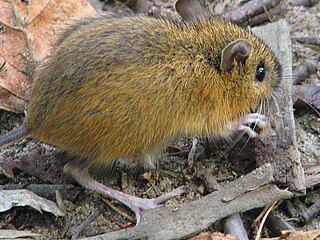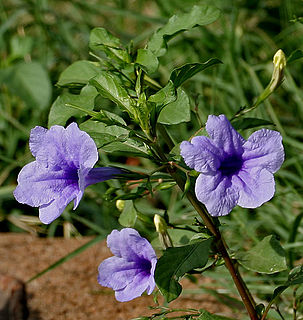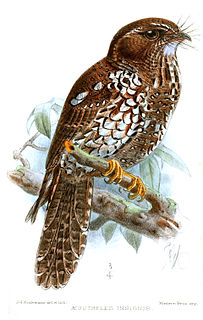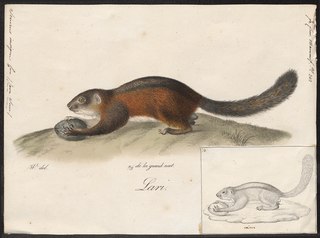
The woodland jumping mouse is a species of jumping mouse found in North America. It can jump up to 3 m (9.8 ft) using its extremely strong feet and long tail.
Striped ground squirrels form a taxon of squirrels under the subfamily Callosciurinae. They are only found in Southeast Asia. Species in this genus include:

Ruellia is a genus of flowering plants commonly known as ruellias or wild petunias. They are not closely related to petunias (Petunia) although both genera belong to the same euasterid clade. The genus was named in honor of Jean Ruelle, herbalist and physician to Francis I of France and translator of several works of Dioscorides.

The European free-tailed bat is a species of free-tailed bat found in the Old World. Other common names include the bulldog bat and the mastiff bat because of the presence of wrinkling on the snout. This bat is found in the Mediterranean region of Europe and in scattered locations across Asia at altitudes from sea level to 3100 m. The range of distribution is from the Canary Islands and Madeira through the whole Mediterranean area, Asia Minor, the Caucasus and the Middle East. In the north to southern France, southern Switzerland, Croatia and Bulgaria. It was reported from Korea in 1931, but has not been sighted on the Korean Peninsula since that time. Populations in Japan, Taiwan and Korea are now considered to be a separate species Tadarida insignis.
The Mindanao montane forest mouse is a species of rodent in the family Muridae. It is found only in the Philippines.
Zenia insignis is a species of legume in the family Fabaceae. It is a medium-sized tree, 15–20 metres (49–66 ft) tall. It is found in southern China and northern Vietnam. It is threatened by habitat loss and overharvesting. The species is under second-class national protection in China.
Nouelia insignis is a species of flowering plant in the family Asteraceae, and the only species in the genus Nouelia. It is found only in Yunnan and Sichuan provinces, China, where it is threatened by habitat loss.

The feline owlet-nightjar is a species of bird in the family Aegothelidae. It is found in New Guinea. Its natural habitat is subtropical or tropical moist montane forests.

The brown-capped weaver is a species of bird in the family Ploceidae. It is found in Angola, Burundi, Cameroon, Republic of the Congo, Democratic Republic of the Congo, Equatorial Guinea, Kenya, Nigeria, Rwanda, South Sudan, Tanzania, and Uganda.

Cassin's honeybird, also known as Cassin's honeyguide, is a species of bird in the family Indicatoridae.

The three-striped ground squirrel is a species of rodent in the family Sciuridae. It is found in Indonesia, Malaysia, and Thailand.
Brycon insignis, the Tiete tetra, is a species of fish in the family Characidae. It is endemic to the Paraíba do Sul River basin in southeast Brazil. B. insignis migrates upstream to spawn and has traditionally been important to fisheries, but it is now a threatened species.
Acanthopale is a plant genus in the Acanthaceae plant family. The genus name is based on the classic Greek words for thorn ákantha and stake palum. Some species in the genus are cultivated as ornamental plants.
Ruellia currorii is a species of plant in the family Acanthaceae. It is found in Angola and Namibia. Its natural habitat is cold desert.
Ruellia dielsii is a species of plant in the family Acanthaceae. It is endemic to Ecuador. Its natural habitat is subtropical or tropical moist montane forests.
Ruellia dioscoridis is a species of plant in the family Acanthaceae. It is endemic to Yemen. Its natural habitats are subtropical or tropical dry shrubland and subtropical or tropical dry lowland grassland.
Ruellia kuriensis is a species of plant in the family Acanthaceae. It is endemic to Yemen. Its natural habitat is subtropical or tropical dry shrubland.
Ruellia paulayana is a species of plant in the family Acanthaceae. It is endemic to Yemen.
Schefflera insignis is a species of plant in the family Araliaceae. It is endemic to China.

Phaulopsis imbricata is a shrub native to South Africa. It is also known as Himalayan ruellia. Leaves are opposite, one larger than the other in each pair, usually asymmetrical at the base. Phaulopsis imbricata is a good fodder, the young leaves are eaten as a vegetable and the plant-ash in oil is rubbed into scarifications on the back for rheumatism in Tanganyika. The flowers have an unpleasant smell. It is filed as near-threatened by the IUCN. It is one of the larval host plants of the butterflies great eggfly, tiny grass blue, brown pansy, soldier pansy and marbled elf.







